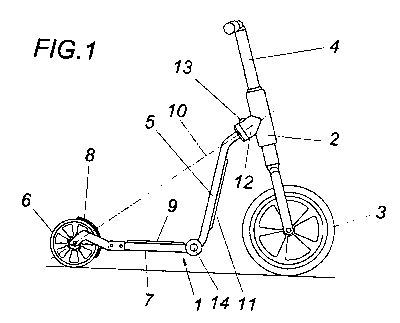Some of the information on this Web page has been provided by external sources. The Government of Canada is not responsible for the accuracy, reliability or currency of the information supplied by external sources. Users wishing to rely upon this information should consult directly with the source of the information. Content provided by external sources is not subject to official languages, privacy and accessibility requirements.
Any discrepancies in the text and image of the Claims and Abstract are due to differing posting times. Text of the Claims and Abstract are posted:
| (12) Patent Application: | (11) CA 2859204 |
|---|---|
| (54) English Title: | SCOOTER |
| (54) French Title: | TROTTINETTE |
| Status: | Deemed Abandoned and Beyond the Period of Reinstatement - Pending Response to Notice of Disregarded Communication |
| (51) International Patent Classification (IPC): |
|
|---|---|
| (72) Inventors : |
|
| (73) Owners : |
|
| (71) Applicants : |
|
| (74) Agent: | ROBIC AGENCE PI S.E.C./ROBIC IP AGENCY LP |
| (74) Associate agent: | |
| (45) Issued: | |
| (86) PCT Filing Date: | 2012-12-12 |
| (87) Open to Public Inspection: | 2013-06-27 |
| Availability of licence: | N/A |
| Dedicated to the Public: | N/A |
| (25) Language of filing: | English |
| Patent Cooperation Treaty (PCT): | Yes |
|---|---|
| (86) PCT Filing Number: | PCT/AT2012/000317 |
| (87) International Publication Number: | WO 2013090953 |
| (85) National Entry: | 2014-06-13 |
| (30) Application Priority Data: | ||||||
|---|---|---|---|---|---|---|
|
A scooter is described with a chassis (1) which has a guide bearing (2) for a steering column (4) holding the front wheel (3) and a supporting arm (5), which has a seat (11), for a pivotable footboard (7) which is provided with a rear wheel (8). In order to achieve simple readjustment to a training bike, it is proposed that the supporting arm (5) which is connected to the footboard (7) is coupled to the guide bearing (2) so as to be pivotable about an axis (10) running through the centre point of the rear wheel (8).
L'invention concerne une trottinette dotée d'un châssis (1) comportant un palier de guidage (2), destiné à une colonne de direction (4) recevant la roue avant (3), et un bras de support (5) comprenant un siège (11) et destiné à un marchepied (7) pivotant pourvu d'une roue arrière (8). L'invention vise à permettre de transformer facilement cette trottinette en draisienne. A cet effet, le bras de support (5) relié au marchepied (7) est articulé sur le palier de guidage (2) de manière à pouvoir pivoter autour d'un axe (10) passant par le centre de la roue arrière (8).
Note: Claims are shown in the official language in which they were submitted.
Note: Descriptions are shown in the official language in which they were submitted.

2024-08-01:As part of the Next Generation Patents (NGP) transition, the Canadian Patents Database (CPD) now contains a more detailed Event History, which replicates the Event Log of our new back-office solution.
Please note that "Inactive:" events refers to events no longer in use in our new back-office solution.
For a clearer understanding of the status of the application/patent presented on this page, the site Disclaimer , as well as the definitions for Patent , Event History , Maintenance Fee and Payment History should be consulted.
| Description | Date |
|---|---|
| Inactive: Dead - RFE never made | 2018-12-12 |
| Application Not Reinstated by Deadline | 2018-12-12 |
| Change of Address or Method of Correspondence Request Received | 2018-12-04 |
| Inactive: Abandon-RFE+Late fee unpaid-Correspondence sent | 2017-12-12 |
| Maintenance Request Received | 2014-11-26 |
| Inactive: Cover page published | 2014-09-09 |
| Inactive: Notice - National entry - No RFE | 2014-08-15 |
| Application Received - PCT | 2014-08-15 |
| Inactive: First IPC assigned | 2014-08-15 |
| Inactive: IPC assigned | 2014-08-15 |
| Inactive: IPC assigned | 2014-08-15 |
| National Entry Requirements Determined Compliant | 2014-06-13 |
| Application Published (Open to Public Inspection) | 2013-06-27 |
There is no abandonment history.
The last payment was received on 2017-11-14
Note : If the full payment has not been received on or before the date indicated, a further fee may be required which may be one of the following
Please refer to the CIPO Patent Fees web page to see all current fee amounts.
| Fee Type | Anniversary Year | Due Date | Paid Date |
|---|---|---|---|
| Basic national fee - standard | 2014-06-13 | ||
| MF (application, 2nd anniv.) - standard | 02 | 2014-12-12 | 2014-11-26 |
| MF (application, 3rd anniv.) - standard | 03 | 2015-12-14 | 2015-11-19 |
| MF (application, 4th anniv.) - standard | 04 | 2016-12-12 | 2016-10-17 |
| MF (application, 5th anniv.) - standard | 05 | 2017-12-12 | 2017-11-14 |
Note: Records showing the ownership history in alphabetical order.
| Current Owners on Record |
|---|
| SCOOT & RIDE GMBH |
| Past Owners on Record |
|---|
| ROBERT KIRCHSCHLAGER |
| WOLFGANG BERNDORFER |